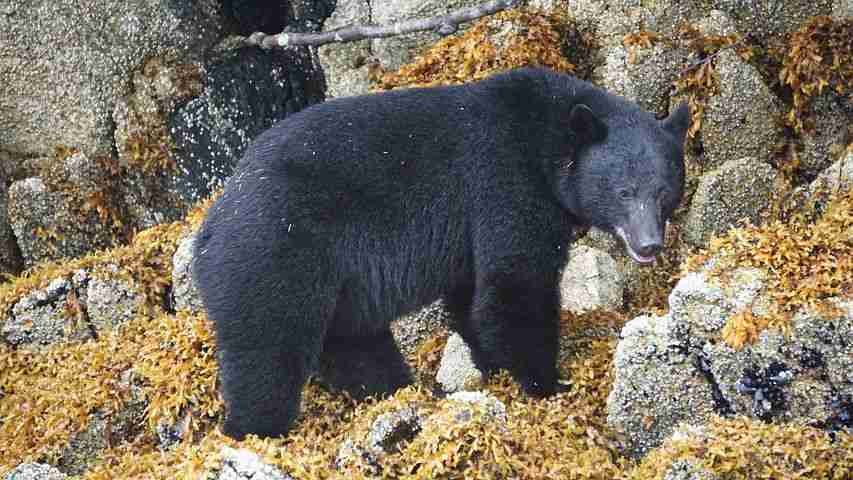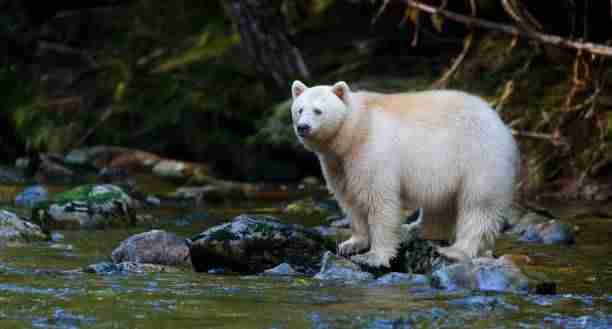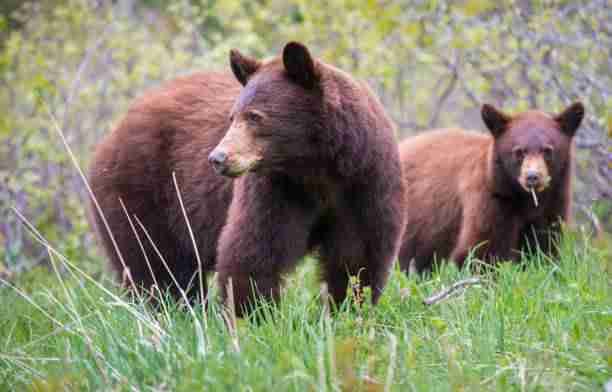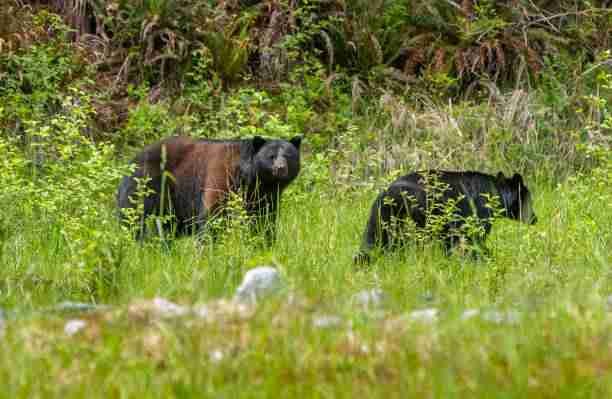It can be hard to identify a bear species with color. For example, a common misconception is brown bears are always
However, is this the same case with black bears?
Black bears are not always black. These bears can also appear brown, cinnamon, white, and even blue. Black bears appear in many colors unlike any other mammal in North America.
In fact, almost all black bears living East of the Great Plains are black. They were the first black bears that early settlers saw and that’s why they were named, “Black bears”.
Now, at this point, the next thing probably on your mind is “why do black bears come in different colors?”.
There’s a reason for this and we’ll explain it in detail below!
Table of Contents
- Why Are Black Bears Not Always Black
- The Other Colors of Black Bears:
- When Do Black Bears Change Color?
- Can Black Bears of Different Colors Interbreed?
- Final Thoughts
Why Are Black Bears Not Always Black
Black bears’ color variation is often regional. In other words, the areas and kind of environment they live in affect the way they appear.
In Regions of the Great Plains (North America):
About 5 to 25 percent of black bears living in forested areas that border the Great Plains have brown fur. And this brown fur comes in different shades.
In addition, you can find brown-colored black bears living in Minnesota. But it’s rare to see a white or blond black bear in this state.
In Open Parts of Western States:
Over half of the black bear species living in open parts of the western states have lighter-colored fur. These areas open park-like forests and mountain meadows.
Moreover, this lighter-colored fur includes brown, blond, or cinnamon black bears. Hence, their kind environment suits bear with lighter fur color.
In Parts of British Columbia:
Black bears living in some parts of British Columbia are white (spirit bears).
Moreover, if you travel to the Glacier regions, farther north of the coast of British Columbia, the black bears have unique bluish-gray fur.
The Other Colors of Black Bears:
Can Black Bears Be Blue?

Yes, black bears can appear bluish. However, they do not entirely have blue-colored fur.
These black bears are a subspecies of black bears known as Glacier bears or sometimes, blue bears (Ursus americanus emmonsil).
Interestingly, these bears mostly have black fur, but they are well known for their dark bluish-gray fur, which is equally silver-tipped.
Furthermore, the blue bears are native to southeastern Alaska, farther north from the coast of British Columbia. “Sik noon”, meaning “a bear that disappears” is the Tlingit name given to the glacier bear.
This name describes their mysterious nature and the way they blend into snowfields pretty well.
Scientists believe that their bluish-gray color came about naturally due to the glacier environment.
However, there’s little scientific explanation for the cause of their unique coloration. It’s a very rare black bear color. Moreover, mountain glaciers no longer isolate their habitat from the neighboring black bear population.
This makes these glacier bears interbreed with black bears that have dominant black genes. And this results in the “bluish-gray” black bear color becoming rarer.
Can Black Bears Be White?

Yes, black bears can be white. However, this is a rare color black bear color. It’s a color that’s unique to the American black bear subspecies known as Kermode bears – the rarest bears on the planet!
Kermode bear habitat is in British Columbia, Canada, specifically the North and Central coast regions. These bears are mostly black but about 20% of them are white – between 100 and 500 individuals.
These white versions go with the nickname, “spirit bears”. In addition, they are not albinos as some might have thought.
This is because their eyes and skin still have pigments unlike animals considered albinos. There’s a genetic reason behind their white fur.
It happen as a result of a change in the Kermode bears’ melanotropin receptor (MC1R) gene, which prevented the production of melanin. Moreover, formed a mutant gene, whicn is equally a recessive.
Hence, a Kermode bear with two copies of this mutant gene will appear white. On the other hand, those having a single copy or none appear black.
Can Black Bears Be Brown?

Yes, black bears can be brown and this is a common fur color of black bears. Some areas have more brown-colored black bears than the black versions.
These brown fur colors can be of different shades, lighter, darker, and even cinnamon. If you journey to the western states, you find that most black bears living there have brown or cinnamon color.
And the reason for this color has to do with a form of natural selection where populations of black bears evolve and adapt to the nature of their environment.
In the western region, the place these brown black bears live is surrounded by large open meadows. Moreover, this kind of habitat lacks trees and this exposes them to direct sunlight.
Since these bears are in the open, the light fur helps them camouflage and hide from their predators such as grizzly bears. Moreover, lighter fur also reduces the heat stress they get in open sunlight.
Having known that even black bears can be brown, you cannot rely on color to differentiate a black bear species from a grizzly or brown bear.
When Do Black Bears Change Color?

Black bears can change their fur colors on many occasions throughout their lives. Moreover, this color change is common with young black bear cubs.
These young cubs can have brown fur that will eventually change to black by the time they become very mature. In addition, black bears shed their fur during summer.
As this happens, the black bear’s appearance can change. A black colored black bear can then transform to a lighter color, likely brown.
Brown-colored black bears, on the other hand, can shed and become even lighter, probably blond. What’s interesting is that their fur returns to its original color when the season cools.
Can Black Bears of Different Colors Interbreed?
Yes, black bears of different colors can interbreed. All colors of black bears—black, brown, bluish-gray, and white—can breed with each other.
It’s safe and they will produce healthy cubs. However, when two black bears of different color mate successfully, the female will end up giving birth to cubs of either color.
Normally the parent with the dominant color gene determines the color of the offspring.
You should also know that most black bears of the same color can produce a cub that has a different color. However, this can only happen when both parents are carrying a gene of that color.
Final Thoughts
In summary, black bears are not always black despite being named “black bears”. These bears can be white, bluish-gray, and equally appear in different shades of brown.
Just so you know, the reason for their coloring mostly has to do with the environment where they live.
Have it in mind that not all black bears are born black. But their colors can change from brown to black when they get older.
What’s more? All black bears can interbreed regardless of their color. Remember, they are all the same species.
Now talking about the same species, are grizzlies and brown bears two different bears? Is it right to call a grizzly bear a brown bear? Click here to find out!

